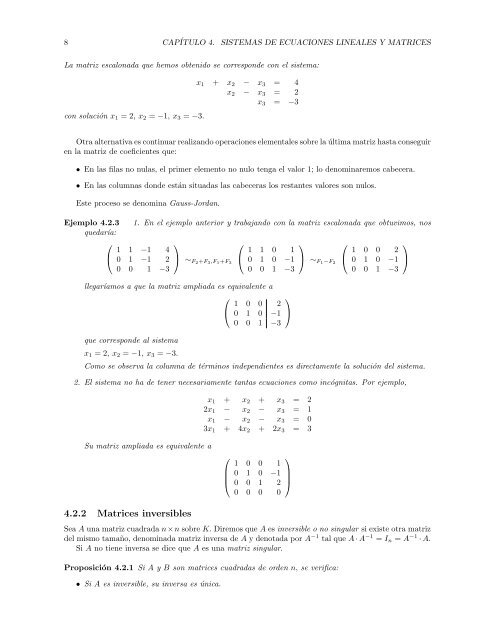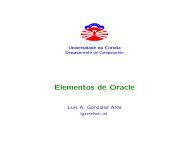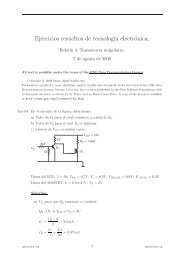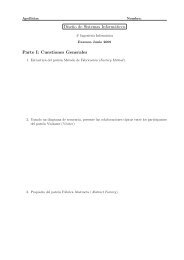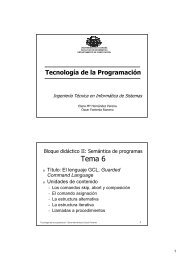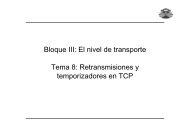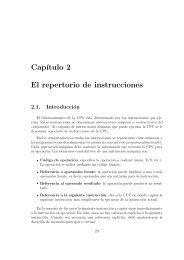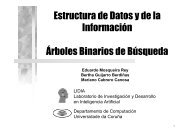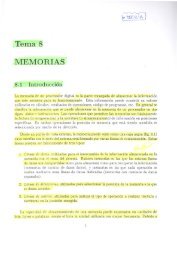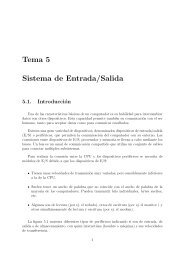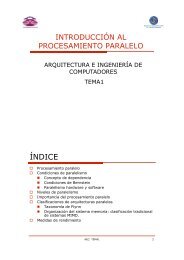Sistemas de Ecuaciones Lineales y Matrices - QueGrande
Sistemas de Ecuaciones Lineales y Matrices - QueGrande
Sistemas de Ecuaciones Lineales y Matrices - QueGrande
Create successful ePaper yourself
Turn your PDF publications into a flip-book with our unique Google optimized e-Paper software.
8<br />
CAPÍTULO 4. SISTEMAS DE ECUACIONES LINEALES Y MATRICES<br />
La matriz escalonada que hemos obtenido se correspon<strong>de</strong> con el sistema:<br />
con solución x 1 = 2, x 2 = −1, x 3 = −3.<br />
x 1 + x 2 − x 3 = 4<br />
x 2 − x 3 = 2<br />
x 3 = −3<br />
Otra alternativa es continuar realizando operaciones elementales sobre la última matriz hasta conseguir<br />
en la matriz <strong>de</strong> coeficientes que:<br />
• En las filas no nulas, el primer elemento no nulo tenga el valor 1; lo <strong>de</strong>nominaremos cabecera.<br />
• En las columnas don<strong>de</strong> están situadas las cabeceras los restantes valores son nulos.<br />
Este proceso se <strong>de</strong>nomina Gauss-Jordan.<br />
Ejemplo 4.2.3<br />
quedaría:<br />
⎛<br />
1. En el ejemplo anterior y trabajando con la matriz escalonada que obtuvimos, nos<br />
⎝ 1 1 −1 4<br />
0 1 −1 2<br />
0 0 1 −3<br />
⎞<br />
⎠ ∼ F2+F 3,F 1+F 3<br />
⎛<br />
⎝ 1 1 0 1<br />
0 1 0 −1<br />
0 0 1 −3<br />
llegaríamos a que la matriz ampliada es equivalente a<br />
⎛<br />
1 0 0 2<br />
⎞<br />
⎝ 0 1 0 −1 ⎠<br />
0 0 1 −3<br />
que correspon<strong>de</strong> al sistema<br />
x 1 = 2, x 2 = −1, x 3 = −3.<br />
⎞<br />
⎠ ∼ F1−F 2<br />
⎛<br />
⎝ 1 0 0 2<br />
0 1 0 −1<br />
0 0 1 −3<br />
Como se observa la columna <strong>de</strong> términos in<strong>de</strong>pendientes es directamente la solución <strong>de</strong>l sistema.<br />
2. El sistema no ha <strong>de</strong> tener necesariamente tantas ecuaciones como incógnitas. Por ejemplo,<br />
x 1 + x 2 + x 3 = 2<br />
2x 1 − x 2 − x 3 = 1<br />
x 1 − x 2 − x 3 = 0<br />
3x 1 + 4x 2 + 2x 3 = 3<br />
⎞<br />
⎠<br />
Su matriz ampliada es equivalente a<br />
⎛<br />
⎜<br />
⎝<br />
1 0 0 1<br />
0 1 0 −1<br />
0 0 1 2<br />
0 0 0 0<br />
⎞<br />
⎟<br />
⎠<br />
4.2.2 <strong>Matrices</strong> inversibles<br />
Sea A una matriz cuadrada n×n sobre K. Diremos que A es inversible o no singular si existe otra matriz<br />
<strong>de</strong>l mismo tamaño, <strong>de</strong>nominada matriz inversa <strong>de</strong> A y <strong>de</strong>notada por A −1 tal que A · A −1 = I n = A −1 · A.<br />
Si A no tiene inversa se dice que A es una matriz singular.<br />
Proposición 4.2.1 Si A y B son matrices cuadradas <strong>de</strong> or<strong>de</strong>n n, se verifica:<br />
• Si A es inversible, su inversa es única.


